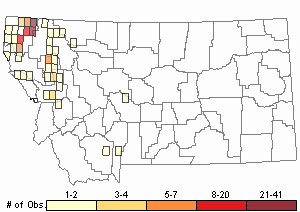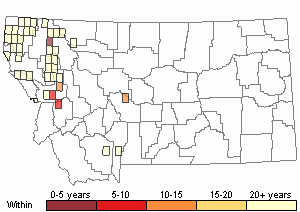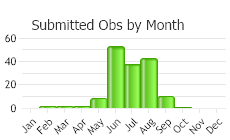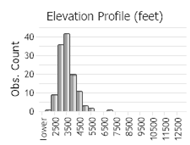View in other NatureServe Network Field Guides
NatureServe
Montana
Utah
Wyoming
Idaho
Wisconsin
British Columbia
South Carolina
Yukon
California
New York
A Ribbed Moss - Aulacomnium androgynum
General Description
Plants: Acrocarpous, growing in dense basal tufts or cushions of dark green, brownish green, occasionally yellow-brown, 1 – 2.5 cm tall, seldom to 4.5 cm (Crum 1981). Stems brownish-green or yellow. Sterile plants with globose clusters of gemmae atop seta-like extensions of the stem (Crum 1981; FNA 2014).
Leaves: Small lower leaves spaced further apart than the larger, somewhat crowded upper leaves. Leaves similar in dry and wet conditions, a little curved, lightly erect, not contorted when dry, 1-3.5 mm in length, slender to widely oblong-lanceolate, broadest above the slightly rounded base, slightly keeled. Margins revolute proximally, sometimes almost to the apex, irregularly toothed in upper half or near apex (sometimes entire in leaves of innovations), often becoming weakly crenate-serrulate below. Costa subpercurrent, occasionally percurrent (Flowers 1973) and flexuose (Crum 1981; FNA 2014).
Leaf Cells: Upper and basal cells similar: erratically-rounded hexagonals (Crum 1981) to almost oblong (FNA 2014) with relatively thick walls and one papilla on both sides. Basal cells 1-stratose, possibly elongated near insertion (Crum 1981; FNA 2014).
Diagnostic Characteristics
A. androgynum is like a smaller version of A. palustre. However, the former’s gemmae are shaped like a spindle and found only at the top of the pseudopodium, whereas the gemmae of A. palustre are almost leaf-like, triangular in shape, and arranged spirally along the pseudopodium’s length. Additionally, A. palustre has swollen brownish cells across the leaf insertions, which A. palustre lacks (Crum 1981).
Range Comments
Canada: BC, NB, NL, NS, ON, PE, QC; USA: AK, CA, CO, ID, IL, ME, MI, MT, NH, NY, OR, SD, WA, WV, WY (FNA 2014). In Montana, known from Carbon, Cascade, Flathead, Gallatin, Granite, Lake, Missoula, Madison,
Mineral, Missoula, Lincoln, and Sanders Counties (Elliott 2016).
Observations in Montana Natural Heritage Program Database
Number of Observations: 170
(Click on the following maps and charts to see full sized version)
Map Help and Descriptions
Relative Density

Recency



 (Observations spanning multiple months or years are excluded from time charts)
(Observations spanning multiple months or years are excluded from time charts)
Habitat
Associated with coniferous forests, growing on organic soil, mineral soil over rock, rotten, bare or charred wood. Probably acid-loving. Low to moderate elevations (Crum 1981; FNA 2014).
Reproductive Characteristics
Setae smooth and 11-25 mm long. Capsules not quite erect to horizontal, 2.5 - 3 mm in length. Endostome cilia long and nodular (Crum 1981; FNA 2014). Dioicous (Crum 1981).
Specialized vegetative reproduction occurs by means of gemmae in a spherical cluster borne on the tip of an extended stem (FNA 2014; Malcolm 2000).
Stewardship Responsibility
References
- Literature Cited AboveLegend:
 View Online Publication
View Online Publication Crum, H.A. and L.E. Anderson. 1981. Mosses of Eastern North America. 2 volumes. Columbia University Press, New York. 1328 pp.
Crum, H.A. and L.E. Anderson. 1981. Mosses of Eastern North America. 2 volumes. Columbia University Press, New York. 1328 pp. Elliott, J.C. and A.K. Pipp. 2018. A Checklist of Montana Mosses (1880-2018). Updated 3 January, 2020. Montana Natural Heritage Program, Helena, Montana. 73 pp.
Elliott, J.C. and A.K. Pipp. 2018. A Checklist of Montana Mosses (1880-2018). Updated 3 January, 2020. Montana Natural Heritage Program, Helena, Montana. 73 pp. Flora of North America Editorial Committee, eds. 2014. Flora of North America North of Mexico. Volume 28. Bryophytes: Mosses, Part 2. Oxford University Press, Inc., NY. xxi + 702 pp.
Flora of North America Editorial Committee, eds. 2014. Flora of North America North of Mexico. Volume 28. Bryophytes: Mosses, Part 2. Oxford University Press, Inc., NY. xxi + 702 pp. Flowers, S. 1973. Mosses: Utah and the West. Brigham Young University, Provo, Utah. 567 p.
Flowers, S. 1973. Mosses: Utah and the West. Brigham Young University, Provo, Utah. 567 p. Malcolm, W. M., and Nancy Malcolm. 2000. Mosses and Other Bryophytes: An Illustrated Glossary. Nelson, New Zealand: Micro-Optics Press.
Malcolm, W. M., and Nancy Malcolm. 2000. Mosses and Other Bryophytes: An Illustrated Glossary. Nelson, New Zealand: Micro-Optics Press.
- Additional ReferencesLegend:
 View Online Publication
View Online Publication
Do you know of a citation we're missing? Elliot, J. C. 1993. Second checklist of Montana mosses. Unpublished report. U.S. Forest Service, Region 1. Missoula, MT. 45 pp.
Elliot, J. C. 1993. Second checklist of Montana mosses. Unpublished report. U.S. Forest Service, Region 1. Missoula, MT. 45 pp. Lawton, E. 1971. Keys for the Identification of the Mosses on the Pacific Northwest. Reprinted from 'Moss Flora of the Pacific Northwest'. Published as Supplement No. 2 of the Journal of the Hattori Botanical Laboratory. Nichinan, Miyazaki, Japan. 66 pp.
Lawton, E. 1971. Keys for the Identification of the Mosses on the Pacific Northwest. Reprinted from 'Moss Flora of the Pacific Northwest'. Published as Supplement No. 2 of the Journal of the Hattori Botanical Laboratory. Nichinan, Miyazaki, Japan. 66 pp. Lawton, E. 1971. Moss Flora of the Pacific Northwest. Hattori Botanical Laboratory. Japan: Yamabuki-cho, Shinjuku-ku, Tokyo. 362 pages plus appendices.
Lawton, E. 1971. Moss Flora of the Pacific Northwest. Hattori Botanical Laboratory. Japan: Yamabuki-cho, Shinjuku-ku, Tokyo. 362 pages plus appendices.
- Web Search Engines for Articles on "A Ribbed Moss"





